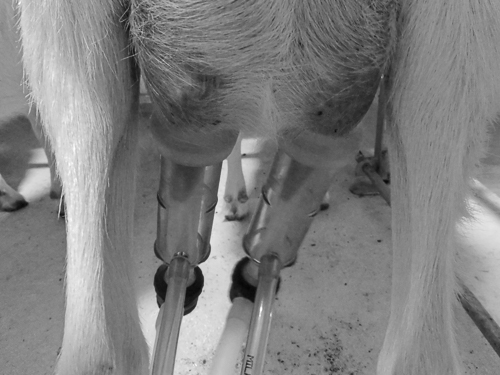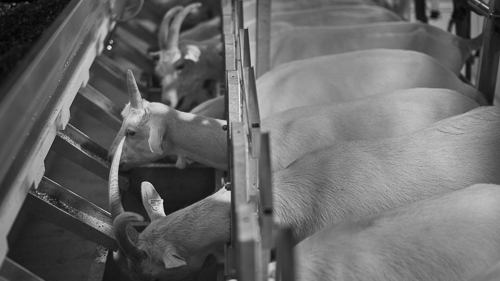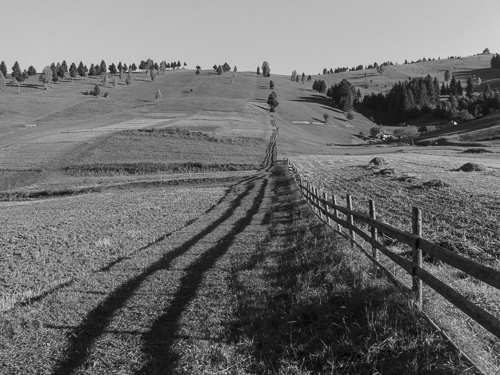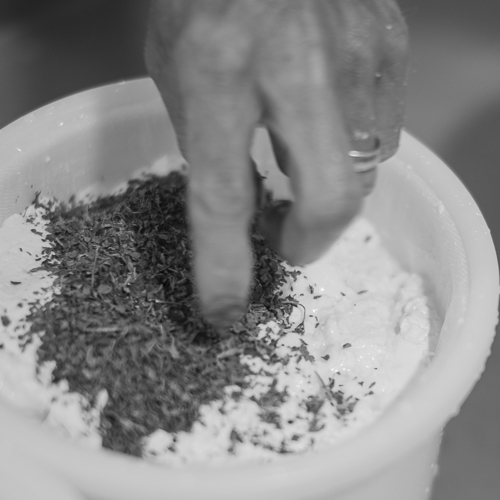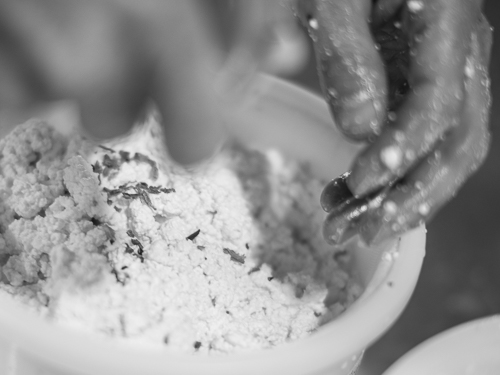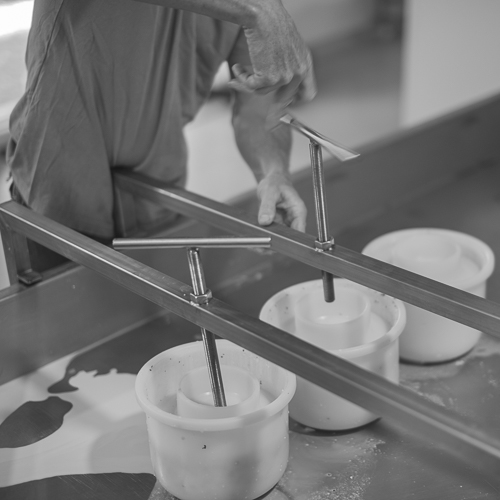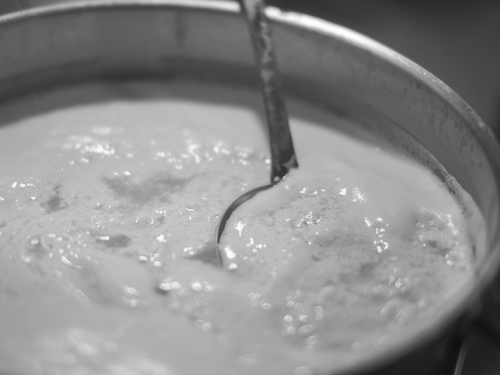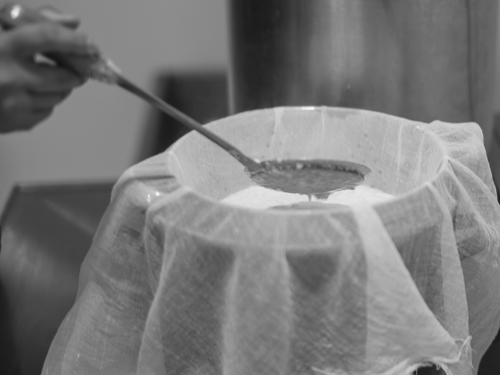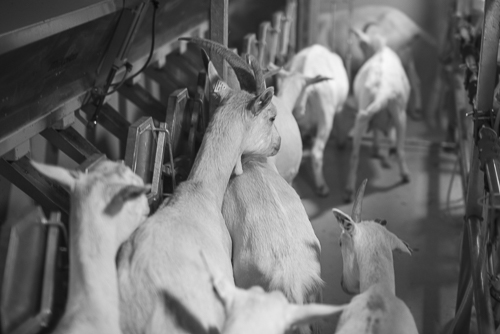 Goats ,which have been milked, are leaving the milking machines
Goats ,which have been milked, are leaving the milking machines
We arrived at about 6 in the morning in pitch darkness at this farm. Somehow we met Jonas, who we followed into the barn where he fed the kids, while a big male was in a separate place. Next, we entered the dairy where a young local man was milking the goats.
The goats moved up a short ramp where they could only turn left to the milking machines. Each goat found its place and started eating fodder. Next, a metal bar was lowered over the necks of all of them. The worker attached pumping devices to the udders and started the milking machine. After some time, the oldest goat at 10 years old, was trampling to show that she didn’t have any more milk.
When the udders of the goats were empty, some transparent plastic containers through which the milk was passing also turned empty. Then, the worker removed the pumping devices and hung them up on a railing. Then, he opened a gate such that the goats could walk down another ramp, next he closed a door such that they couldn’t return. The same procedure was redone until all the goats had been milked.
After he had finished the milking, he emptied the remaining milk in a hose into a container with the rest of the milk. Next, he rinsed all the equipment and carried the container to the dairy. There, Jonas poured the milk into a stainless steel container, turned on heat and waited till it reached about 40°C. Next, he added liquid mould, rennet and a liquid which increased yield. That is, it turned more milk into cheese. Thereafter, we went for breakfast.
The companies, which are producing milking machines, didn’t want to give Jonas a quote. One company had a subsidiary in Bucharest and they sent him a quote, but they didn’t want to come here. In the end, he connected all mains electricity and plumbing himself to the dairy. Finally, the company was willing to send two technicians to his place and assemble the milking machinery.
The ditch with cables we saw last time had been refilled and a building had been set up where the goats were milked by means of machines.
He brought goats from Belgium, but it was very difficult to get them registered by the local vets, although inspecting goats is easier than cows. In the end, he had to bring the vets to his place and bring them back again when they were finished.
He has 14 milking goats and 8 small ones, which were born this year. In addition, he had slaughtered 2 male goats. He thinks 24 goats would be enough since the milking machine can accommodate 12 goats only.
Jonas told us that the goats stop producing milk in winter and they start producing milk again about 1 March. He’s using this period to work as a freelance engineer on ships, being well paid and saving money for the rest of the year.
He spent the summer haymaking, doing manual mowing only and he took part in all stages of it because buying hay isn’t an option.
The hillsides above the farm have lots of flowers and they smell like an organic, herbal tea shop. This is good for the goats because they are what they eat and, of course, for the cheese. He mowed the grass on the hills above the house, put it on tarpaulins and pulled it down to the house, making haystacks, else he would have to hire a horse, driver and cart and freight it here.
Several farmers are mowing grass to receive subsidies although they have no animals and they throw away the grass.
Before it was easy to mow someone’s land where he left 2/3 to the owner and took 1/3 himself, but not any more.
Some owners come to him and ask him to mow the land and pay him for the work, but he needs workers. It’s simply too much work for one person. Since fewer people work the land, lots of hay is not cut any more.
Many people between 20 and 50 work abroad, doing work, which Western Europeans don’t want. This means that Jonas has problems getting workers to help him.
Some local people earn a lot of money in Western Europe, then come back and spend it, but they don’t want to work here.
When Jonas and his wife Katalin first came to Mircurea Ciuc, he looked for an engineering job, but none was available. Since he had always liked goats, he decided to be a goat farmer instead. First, he had to ask his neighbours within a radius of 100 m if they would accept that he started a goat farm and all of them accepted, but only one could sign his name. Jonas had to sign for the rest.
However, he can’t get a subsidy if the land is not registered. That is, he needs to prove that he’s the owner of the land. The land around Mircurea Ciuc was registered during the communist period, but the Gyimes valley was ignored.
As described here, lots of land was divided among family members into small plots before the communist period.
Jonas told us the following regarding registering of land:
⦁ When a surveyor appears in a village, he is often surrounded by those who are most greedy.
⦁ Some people claim they own land they don’t own when the surveyor appears. Many people are illiterate and are easy to fool.
⦁ A quick survey method had to be abandoned because so many “smart” people were claiming land from their neighbours. In addition, if one sibling stayed at home and the other ones were away, he could claim all the land as his.
⦁ People who work at the land registry in Bucharest work very slowly regarding registering land in the Hungarian-speaking part of the country.
⦁ Lots of land has been registered in the Romanian-speaking part.
⦁ The Romanian government was imposed by the EU to register all land within 2018, but many parts of the Hungarian-speaking land are still not registered. The Romanian government wants to register uninhabited land in order to increase quickly the amount of registered land, but it won’t help people where they live. Unfortunately, registering land where people live is more time-consuming.
⦁ Jonas and 5-6 other farmers have formed an association to speed up registering of their land.
After breakfast, we went back to the dairy where a young local woman was cleaning and working as an assistant for Jonas. He transferred the curds to porous plastic buckets by opening a valve at the base of the stainless steel container and letting the contents flow out. Next, he laid the buckets on a metal table with a hole through which the whey could escape.
He added dried nettle to the curds in the two porous buckets and mixed it thoroughly with his hands. Next, he added peppers to two other porous buckets and mixed it with the curds again.
After he had mixed the curds with dried herbs, he added more curd and mixed everything again. Thereafter, he put on lids on all the buckets and put pressure on them. Later, he would release the pressure and turn the buckets upside down. Next, he would lay the cheeses in salt water. The day after, he would put them in a cool room for maturing.
While Jonas was making cheese, the young woman was making ricotta. When he had removed all the curds from the stainless steel container, he emptied the remaining whey into a kettle. By heating it, white flakes of curd started appearing on the surface of the whey after some time. When there was enough curd on the surface, she used a sieve with a handle to lift it up and put it in a perforated plastic basket, letting the remaining whey flow out and the ricotta remain.
When she wasn’t making cheese or ricotta, she was cleaning and after both making cheese and ricotta was finished, she cleaned everything, which had been used.
As regards making soft cheese, Jonas told us that some whey should stay in the curd, the cheese should be laid on a metal grid, it should be turned upside down twice daily. White mould should start appearing on the surface of the cheese after 2-3 days. If not, it is probably not suitable for human consumption.
One of his cheeses was full of small holes resembling somewhat a Swiss cheese. I asked him why it looked like that and he said that it was something the goats were eating.
Jonas told us that demand is larger than supply. He delivers his cheeses to a vegetarian restaurant in Mircurea Ciuc and to a burger place in the same town.
According to Jonas, city people think cow farmers are better than goat farmers.
He told us that EU funds are much easier to get for big farms, but very difficult for small ones because there is a lot of paperwork, which has to be filled out. Big farms can pay someone to do it, but it’s not possible for small ones.
One day, inspectors, who were extremely meticulous, came to him without warning, but they couldn’t find anything apart from some paperwork, which had to be finished within a certain time.
They asked him the usual question: where does the water come from? From the hills above the farm. He had to provide a water sample, a milk sample, a bottle sample and a cheese sample to them. Everything was analysed and found to be ok. In the end, he asked them why they did it and they gave him a white lie. He said he didn’t believe them and finally they admitted that envious people in the village had sent them. He almost gave up the farm after the inspection. Fortunately, he’s still raising goats and making goat’s cheese.
The local high school wants to send pupils to local companies for practise because they are tired of reading and sitting in a classroom. Only Trifolium Kajo, the ski slope and the dairy can employ young people, though.
Jonas had two adolescents here and he tried to teach them about his farm, asking them questions about the dairy to test if they had learnt their lessons. He also let them drive a small tractor.
There should be a cheese conference in Bucharest the week after our visit. While there, he would present his problems in public.
His cheeses are not bio-certified products, but they are good enough. There is too much paperwork to get them certified as organic products.
Jonas and Katalin accept and accommodate volunteers from WWOOF Romania as described here.
A wwoofer from Belgium was present and a couple from Australia would arrive later. Now, he needs help with building work, before he needed help for mowing.
He also said that he had bought a house not far away from the farm. He wanted to rent it out and he had hired a carpenter to refurbish it. Unfortunately, only one German family had staid there this summer.
The house is on registered land and it has space for 9 people. He had kept an old apple tree near the house although the carpenter wanted to cut it because he said it was in the way when he was working. He showed us the house too and it looked very modern inside.
Surprisingly, he was refurbishing the barn himself as if he hadn’t enough to do before.
For those who want peace and quiet, lovely scenery and good hiking terrain, it should be an excellent choice.
Last but not least, he always wore a hat during our last visit, while this time he showed us what was remaining of his unruly hair!
